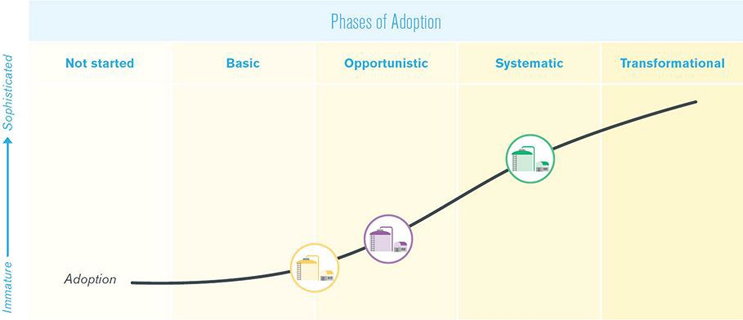Seizing The Digital Opportunity For Water
By Joseph Vesey And Kala Vairavamoorthy
The journey toward intelligent water can be expedited with eight key steps — a guideline for gliding through the Digital Water Adoption Curve.
Global water challenges are placing more pressure on water managers and the communities they serve than ever before. Issues like water affordability, scarcity, resilience in the face of severe weather patterns, and water quality concerns are impacting water systems and citizens all over the world.
The challenges are growing, yet at the same time, there have never been more reasons to feel optimistic about our water future. A new white paper from the International Water Association (IWA), global water technology company Xylem, and the Water Foundry harnesses insights from utilities leading the digital transformation of the sector, outlining a path to progress for utilities looking to follow in their steps.
From Crisis To Opportunity — Digital Innovation Holds The Key
As we have seen in so many other sectors — from transportation to aerospace to financial services to healthcare and beyond — digital innovation creates new paradigms, transforming the economics and possibilities of industries and advancing the way we work and live.
Against a backdrop of escalating water challenges, water and wastewater utilities are turning to new and innovative solutions, including digital technologies, to leverage data and analytics to drive sustainable water management. This “decision intelligence” is transforming and optimizing water, and the results that “early adopter” utilities are achieving are powerful and game-changing. From reducing combined sewer overflows by a billion gallons a year to cutting non-revenue water losses dramatically, water operators are reinventing water management, creating water, energy, and cost efficiencies that a decade ago were unimaginable.
Mapping Digital Adoption Trends To Drive Water Sector Transformation
The digital journey of water is gaining momentum, but is in its early days. Seeking to advance the industry’s understanding of digital migration, the white paper convenes insights from 40 utilities and over 20 industry thought leaders globally to examine how digitalization is transforming the sector. Urging water leaders to think boldly about their digital future, Digital Water: Industry Leaders Chart the Transformation Journey1 provides utility decision-makers with actionable learnings to accelerate their adoption of digital solutions.
The paper also lays the foundation of the newly launched IWA Digital Water Program,2 which is a gateway for water utilities to access knowledge on research, technology, and innovation in the digital water space.
No One Can Solve Water Alone
Just as water stakeholders can model digital success stories from other industries, there is much to learn from early adopters in our own sector, and this paper provides a comprehensive resource and map. By tracing the digital journey and capturing the experiences of dozens of utility pioneers, we aim to start a dialogue and build a body of knowledge that can inform and inspire water managers around the globe.
“The world is moving in the direction of technology,” said Richard Appiah Otoo, chief technology officer, Ghana Water Company Limited. “Ghana Water experienced a 14 percent increase in revenue after digital technologies increased water bill collection efficiency and provided customers with a mobile billing option.”
Biju George, executive vice president, DC Water, commented: “The digital strategy has to become a corporate strategy. It’s not an option to sit there and let it happen — you have to plan for it. You have to train your employees toward that. You have to relook at every process. You have to design your systems to give you the data you need to make efficient decisions.”
“If you have any doubt, just try it,” said Claire Falzone, CEO, Nova Veolia-France. “Try small at first, if you don’t dare to dream big. This is just the beginning of the digital water journey, and if you don’t adopt digital technologies, someone else will.”
Tracking Progress Using The Digital Water Adoption Curve
Utilities are at varying levels of maturity in adopting digital solutions and approaches. The Digital Water Adoption Curve, adapted from Gartner 2017, is a synthesized view of how utilities are adopting digital technologies. Intended to be a working tool for utilities now and in the future, the Digital Water Adoption Curve provides a means for utilities to assess where they are in their digital maturation and to establish a clear road map to progress their migration.
The maturation of a water or wastewater utility along the curve is shown as a utility progresses from having little to no digital infrastructure to having opportunistic, systematic, and transformational digital systems and strategies.
In the interviews and surveys of leading utilities, executives were asked to reflect on their organizations and assess their own phases of digital maturity. Responses spanned the entire Digital Water Adoption Curve spectrum, with some utilities having conservative beginnings and others already largely embracing the full expanse of digital technologies. With an average adoption level of “Opportunistic,” it appears that many of the utilities surveyed and interviewed have started their digital water transformation journeys.
The study finds that those utilities in early development stages are focusing efforts on implementing software platforms, new sensors, and smart meters, increasing automation for remote control, combining networks, and enhancing internal infrastructure. Utilities further along in their digital maturation have already incorporated technologies like VR and Big Data into automated processes and decision-making, helping to run smart solutions or, in some cases, expand beyond their organization to provide services and support to external utilities.

Advancing Along The Digital Water Journey
Eight overarching actions have been identified to accelerate a utility’s journey along the Digital Water Adoption Curve:
- Set the ambition at the CEO and board level. Utility leaders agreed that having the support and leadership of the utility’s executive team and board is a critical accelerator of the implementation of digital technologies.
- Build a holistic digital road map and a clear business strategy. Utilities must create internal consensus on how the digital journey will unfold, maintain the customer and business outcomes as focal points throughout the digitalization process, and educate key stakeholders (consumers, politicians, shareholders, management, and employees).
- Create an innovation culture. Utility operators, IT staff, finance, technicians, executives, and others have to be the scouts for identifying new technologies. However, to drive adoption, utilities must focus on fostering an organization-wide curiosity and competency for embracing digital innovation.
- Leverage pilots for an agile mind-set. Pilot projects offer a means to explore new technologies, build momentum, and create a more holistic understanding of their physical and financial effects on operations before committing to large-scale implementation.
- Develop architecture for optimizing data use. Developing a data warehouse, where operational data sets become available to functions such as finance, engineering, and IT specialists who can use the data to optimize business processes, is critical to creating value from data and effectively digitalizing utility infrastructure and connectivity.
- Cultivate your digital ecosystem. Utilities should leverage insights on digital migration from peers, industry associations, academics, and technology hubs/accelerators who are further ahead of them on the Digital Water Adoption Curve. Fortunately, there is openness and a willingness to share information within the water sector, and utilities should actively seek out these insights.
- Embrace the digital water value case. The digital water value drivers within the utility, surrounding community, and in the long-term, are diverse and transformational, resulting in a compelling case for accelerated adoption. The community, operational, financial, and resiliency benefits created by digital technologies generate exponential value for utilities.
- The water sector needs to unite around solving key barriers. Key barriers such as interoperability, regulations, culture, and cybersecurity must be addressed by the industry as a whole. Any platform for the adoption of digital technologies by utilities must begin with a thorough understanding of those technologies, the recognition of specific challenges faced by the utility, and a commitment to executing a strategy to address those challenges with new and innovative technologies and practices. It is important to remember, however, that the technologies will change and that the technologies themselves are not the solution. Rather, their implementation and the various ways in which they create value for a utility will be the solution to some of water and wastewater utilities’ greatest challenges (e.g., non-revenue water, stormwater and sewage overflow, etc.).
The Opportunity Of A Lifetime
The world has to think and act differently about water. There simply is no other choice. Water challenges like scarcity, affordability, and resilience are placing millions of human lives at risk, endangering our environment and the global economy, and impeding social progress. These urgent threats are not some far-off problem. They are upon us and growing by the day. We need step-change, and digital innovation is the answer.
Digital Water: Industry Leaders Chart the Transformation Journey is a call to action to water stakeholders around the globe to work collaboratively to drive our industry forward. The technology to transform water is already available today. We need water stakeholders to come together to accelerate the adoption of these digital solutions — so more water systems and the communities they serve can reap the benefits. By sharing the experiences and knowledge of innovation trailblazers throughout the sector, we can advance the dialogue around digital water and help build a movement.
We have the opportunity of a lifetime to solve water and to change history — let’s seize it.
References
- https://iwa-network.org/publications/digital-water/
- https://iwa-network.org/projects/digital-water-programme/
About The Authors
 Joe Vesey, Senior Vice President and Chief Marketing Officer of Xylem, is responsible for the company’s marketing function, focusing on the unique needs of customers in specific industry verticals, expanding digital marketing efforts, building commercial excellence, and further developing key account management capabilities and integrated IT efforts to accelerate commercial excellence. He also oversees global public affairs and branding. Mr. Vesey currently serves as Chairman of the Xylem Watermark Committee, which is the company’s corporate citizenship and social investment program. He earned a BS in Chemical Engineering from Lehigh University and an MBA from Boston University
Joe Vesey, Senior Vice President and Chief Marketing Officer of Xylem, is responsible for the company’s marketing function, focusing on the unique needs of customers in specific industry verticals, expanding digital marketing efforts, building commercial excellence, and further developing key account management capabilities and integrated IT efforts to accelerate commercial excellence. He also oversees global public affairs and branding. Mr. Vesey currently serves as Chairman of the Xylem Watermark Committee, which is the company’s corporate citizenship and social investment program. He earned a BS in Chemical Engineering from Lehigh University and an MBA from Boston University
 Prof. Kala Vairavamoorthy, Executive Director of the International Water Association, is an internationally recognized water resource management expert with particular expertise in urban water issues. He has published extensively and has a strong international profile working closely with the World Bank, UN-Habitat, UNESCO, GWP, SIWI, and the EU. This includes leading several urban water management projects for the World Bank, African Development Bank, Asian Development Bank, and DFID. Kala has a PhD and MSc in Environmental Engineering from Imperial College, University of London, UK and a BSc (Hons) from King’s College, London.
Prof. Kala Vairavamoorthy, Executive Director of the International Water Association, is an internationally recognized water resource management expert with particular expertise in urban water issues. He has published extensively and has a strong international profile working closely with the World Bank, UN-Habitat, UNESCO, GWP, SIWI, and the EU. This includes leading several urban water management projects for the World Bank, African Development Bank, Asian Development Bank, and DFID. Kala has a PhD and MSc in Environmental Engineering from Imperial College, University of London, UK and a BSc (Hons) from King’s College, London.
